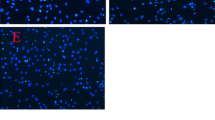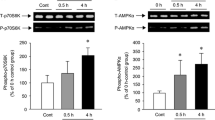Abstract
Mechanical stretch exerted pro-apoptotic effect on myoblasts, the mechanism of which is currently unknown. Intracellular Ca2+ accumulation has been implicated in stretch-induced apoptosis. calreticulin (CRT) and plasma membrane Ca2+ transporting ATPase 1 (PMCA1) are two critical components of Ca2+ signaling system participating in intracellular Ca2+ homeostasis. In this study, we explored the contribution of CRT and PMCA1 in mediating stretch-induced Ca2+ accumulation and apoptosis of myoblasts. Stretching stimuli elevated level of CRT while inhibited activity of PMCA1. Moreover, there were bidirectional regulations between CRT and PMCA1, which formed the positive feedback loop leading to continuous increment of CRT level and repression of PMCA1 activity, in stretched myoblasts. Specifically, increased CRT level inhibited PMCA1 activity via suppressing Calmodulin (CaM), while reduced PMCA1 activity promoted CRT expression through activating p38MAPK pathway. Thus, the CRT-CaM-PMCA1 and PMCA1-p38MAPK-CRT pathways constituted a close cycle comprising CRT, PMCA1, CaM and p38MAPK. Inhibition of both CaM and p38MAPK affected the other three factors in stretched myoblasts. Circulation of the vicious cycle resulted in escalated Ca2+ overloading in myoblasts under continuous stretching stimuli. CRT knock-down, PMCA1 overexpression, and p38MAPK inhibition all attenuated the raised intracellular Ca2+ level and ameliorated myoblast apoptosis in the stretching environment. Conversely, CRT overexpression, PMCA1 knock-down, and CaM inhibition all aggravated stretch-induced Ca2+ overloading and myoblast apoptosis. A positive feedback loop between CRT and PMCA1 was activated in stretched myoblasts, which contributed to intracellular Ca2+ accumulation and resultant myoblast apoptosis.









Similar content being viewed by others
Data availability
The datasets generated during and/or analysed during the current study are available from the corresponding author on reasonable request.
Abbreviations
- CRT:
-
Calreticulin
- PMCA1:
-
Plasma membrane Ca2+ transporting ATPase 1
- ER:
-
Endoplasmic reticulum
- TUNEL:
-
Terminal deoxynucleotidyl transferase-mediated dUTP-biotin nick end labeling
- DAPI:
-
4′,6-Diamidino-2-phenylindole
- FACS:
-
Fluorescence activated cell sorting
- FITC:
-
Fluorescein isothiocyanate
- CaM:
-
Calmodulin
- OE:
-
Overexpressing:
- KD:
-
Knock-down
- EGTA:
-
Ethylene glycol tetra-acetic acid
References
Wisdom KM, Delp SL, Kuhl E (2015) Use it or lose it: multiscale skeletal muscle adaptation to mechanical stimuli. Biomech Model Mechanobiol 14(2):195–215
Song J et al (2019) Stretching magnitude-dependent inactivation of AKT by ROS led to enhanced p53 mitochondrial translocation and myoblast apoptosis. Mol Biol Cell 30(10):1182–1197
Song J et al (2018) Cleavage of caspase-12 at Asp94, mediated by endoplasmic reticulum stress (ERS), contributes to stretch-induced apoptosis of myoblasts. J Cell Physiol 233(12):9473–9487
Wang F et al (2017) Apoptosis inducing factor is involved in stretch-induced apoptosis of myoblast via a caspase-9 independent pathway. J Cell Biochem 118(4):829–838
Zhang Q et al (2016) Caspase-12 is involved in stretch-induced apoptosis mediated endoplasmic reticulum stress. Apoptosis 21(4):432–442
Du Y et al (2019) MiR-147 inhibits cyclic mechanical stretch-induced apoptosis in L6 myoblasts via ameliorating endoplasmic reticulum stress by targeting BRMS1. Cell Stress Chaperones 24(6):1151–1161
Patergnani S et al (2020) Various aspects of calcium signaling in the regulation of apoptosis, autophagy, cell proliferation, and cancer. Int J Mol Sci 21(21):8323
Boczek T et al (2021) Crosstalk among calcium ATPases: PMCA, SERCA and SPCA in mental diseases. Int J Mol Sci 22(6):2785
Wang YP, Shi J, Tong XY (2021) Cross-talk between mechanosensitive ion channels and calcium regulatory proteins in cardiovascular health and disease. Int J Mol Sci 22(16):8782
Sepulveda MR et al (2007) Functional and immunocytochemical evidence for the expression and localization of the secretory pathway Ca2+-ATPase isoform 1 (SPCA1) in cerebellum relative to other Ca2+ pumps. J Neurochem 103(3):1009–1018
Benaim G et al (1991) A calmodulin-activated (Ca2+−Mg2+)-ATPase is involved in Ca2+ transport by plasma membrane vesicles from Trypanosoma cruzi. Biochem J 280(Pt 3):715–720
Perez-Gordones MC et al (2017) Evidence of the presence of a calmodulin-sensitive plasma membrane Ca2+-ATPase in Trypanosoma equiperdum. Mol Biochem Parasitol 213:1–11
Murata N et al (2014) Ca2+ influx and ATP release mediated by mechanical stretch in human lung fibroblasts. Biochem Biophys Res Commun 453(1):101–105
Huang W et al (2020) Local strain distribution and increased intracellular Ca2+ signaling in bovine articular cartilage exposed to compressive strain. J Biomech Eng. https://doi.org/10.1115/1.4045807
Yamamoto K, Imamura H, Ando J (2018) Shear stress augments mitochondrial ATP generation that triggers ATP release and Ca2+ signaling in vascular endothelial cells. Am J Physiol Heart Circ Physiol 315(5):H1477–H1485
Zhivotovsky B, Orrenius S (2011) Calcium and cell death mechanisms: a perspective from the cell death community. Cell Calcium 50(3):211–221
Xu B et al (2019) Excessive mechanical stress induces chondrocyte apoptosis through TRPV4 in an anterior cruciate ligament-transected rat osteoarthritis model. Life Sci 228:158–166
Hutcheson JD et al (2012) Intracellular Ca2+ accumulation is strain-dependent and correlates with apoptosis in aortic valve fibroblasts. J Biomech 45(5):888–894
Yang Q et al (2019) Study on the mechanism of excessive apoptosis of nucleus pulposus cells induced by shRNA-Piezo1 under abnormal mechanical stretch stress. J Cell Biochem 120(3):3989–3997
Matsui H et al (2014) The expression of Fn14 via mechanical stress-activated JNK contributes to apoptosis induction in osteoblasts. J Biol Chem 289(10):6438–6450
Nakamura A, Harrod GV, Davies KE (2001) Activation of calcineurin and stress activated protein kinase/p38-mitogen activated protein kinase in hearts of utrophin-dystrophin knockout mice. Neuromuscul Disord 11(3):251–259
Arnaudeau S et al (2002) Calreticulin differentially modulates calcium uptake and release in the endoplasmic reticulum and mitochondria. J Biol Chem 277(48):46696–46705
Kageyama K et al (2002) Overexpression of calreticulin modulates protein kinase B/Akt signaling to promote apoptosis during cardiac differentiation of cardiomyoblast H9c2 cells. J Biol Chem 277(22):19255–19264
Nakamura K et al (2000) Changes in endoplasmic reticulum luminal environment affect cell sensitivity to apoptosis. J Cell Biol 150(4):731–740
Groenendyk J, Lynch J, Michalak M (2004) Calreticulin, Ca2+, and calcineurin—signaling from the endoplasmic reticulum. Mol Cells 17(3):383–389
Toischer K et al (2012) Mechanical load-dependent cardiac ER stress in vitro and in vivo: effects of preload and afterload. FEBS Lett 586(9):1363–1369
Li H et al (2013) Endoplasmic reticulum stress regulates rat mandibular cartilage thinning under compressive mechanical stress. J Biol Chem 288(25):18172–18183
Castillero E et al (2015) Attenuation of the unfolded protein response and endoplasmic reticulum stress after mechanical unloading in dilated cardiomyopathy. Am J Physiol Heart Circ Physiol 309(3):H459–H470
Wei H et al (2022) Calreticulin silencing inhibits extracellular matrix synthesis of human gingival fibroblasts cultured on three-dimensional poly(lactic-co-glycolic acid) scaffolds by inhibiting the calcineurin/nuclear factor of activated T cells 3 signalling pathway. Ann Anat 239:151820
Guan L et al (2018) Diazoxide induces endoplasmic reticulum stress-related neuroprotection mediated by p38 MAPK against Abeta25-35 insults. Eur Rev Med Pharmacol Sci 22(18):6133–6138
Wu X et al (2007) Hypoxic preconditioning induces delayed cardioprotection through p38 MAPK-mediated calreticulin upregulation. Shock 27(5):572–577
Yamazaki T et al (2004) Suppressive effects of FR167653, an inhibitor of p38 mitogen-activated kinase, on calreticulin mRNA expression induced by endoplasmic reticulum stresses. Eur J Pharmacol 484(2–3):147–156
Afroze T, Husain M (2000) c-Myb-binding sites mediate G(1)/S-associated repression of the plasma membrane Ca2+-ATPase-1 promoter. J Biol Chem 275(12):9062–9069
Habib T et al (2007) Myc stimulates B lymphocyte differentiation and amplifies calcium signaling. J Cell Biol 179(4):717–731
Minich RR, Li J, Tempel BL (2017) Early growth response protein 1 regulates promoter activity of alpha-plasma membrane calcium ATPase 2, a major calcium pump in the brain and auditory system. BMC Mol Biol 18(1):14
Lessard S et al (2017) An erythroid-specific ATP2B4 enhancer mediates red blood cell hydration and malaria susceptibility. J Clin Invest 127(8):3065–3074
Verma AK et al (1994) Regulatory region of plasma membrane Ca2+ pump 28 residues suffice to bind calmodulin but more are needed for full auto-inhibition of the activity. J Biol Chem 269(3):1687–1691
Paszty K et al (2002) Plasma membrane Ca2+ATPase isoform 4b is cleaved and activated by caspase-3 during the early phase of apoptosis. J Biol Chem 277(9):6822–6829
Schwab BL et al (2002) Cleavage of plasma membrane calcium pumps by caspases: a link between apoptosis and necrosis. Cell Death Differ 9(8):818–831
Bruce JIE (2018) Metabolic regulation of the PMCA: role in cell death and survival. Cell Calcium 69:28–36
Dalghi MG et al (2013) Plasma membrane calcium ATPase activity is regulated by actin oligomers through direct interaction. J Biol Chem 288(32):23380–23393
Vanagas L et al (2013) Differential effects of G- and F-actin on the plasma membrane calcium pump activity. Cell Biochem Biophys 66(1):187–198
Dalghi MG, Ferreira-Gomes M, Rossi JP (2018) Regulation of the plasma membrane calcium ATPases by the actin cytoskeleton. Biochem Biophys Res Commun 506(2):347–354
Szabo E, Papp S, Opas M (2007) Differential calreticulin expression affects focal contacts via the calmodulin/CaMK II pathway. J Cell Physiol 213(1):269–277
Szabo E et al (2008) Calreticulin inhibits commitment to adipocyte differentiation. J Cell Biol 182(1):103–116
Papp S et al (2008) Kinase-dependent adhesion to fibronectin: regulation by calreticulin. Exp Cell Res 314(6):1313–1326
Szabo E et al (2009) Cell adhesion and spreading affect adipogenesis from embryonic stem cells: the role of calreticulin. Stem Cells 27(9):2092–2102
Feng H et al (2021) Cigarette smoke extracts induce apoptosis in Raw2647 cells via endoplasmic reticulum stress and the intracellular Ca2+/P38/STAT1 pathway. Toxicol In Vitro 77:105249
Zhu G et al (2019) PKA- and Ca2+-dependent p38 MAPK/CREB activation protects against manganese-mediated neuronal apoptosis. Toxicol Lett 309:10–19
Kwon CH et al (2009) Ciglitazone induces apoptosis via activation of p38 MAPK and AIF nuclear translocation mediated by reactive oxygen species and Ca2+ in opossum kidney cells. Toxicology 257(1–2):1–9
Abell E et al (2011) Parallel adaptive feedback enhances reliability of the Ca2+ signaling system. Proc Natl Acad Sci USA 108(35):14485–14490
Wang Y et al (2020) Multiple effects of mechanical stretch on myogenic progenitor cells. Stem Cells Dev 29(6):336–352
Arnadottir J, Chalfie M (2010) Eukaryotic mechanosensitive channels. Annu Rev Biophys 39:111–137
Coste B et al (2010) Piezo1 and Piezo2 are essential components of distinct mechanically activated cation channels. Science 330(6000):55–60
Christensen AP, Corey DP (2007) TRP channels in mechanosensation: direct or indirect activation? Nat Rev Neurosci 8(7):510–521
Sakamoto Y et al (2010) Distinct mechanosensitive Ca2+ influx mechanisms in human primary synovial fibroblasts. J Orthop Res 28(7):859–864
Du G et al (2020) Roles of TRPV4 and piezo channels in stretch-evoked Ca2+ response in chondrocytes. Exp Biol Med 245(3):180–189
Acknowledgements
The authors thank the laboratory members of Central Laboratory of Affiliated Hospital of Qingdao University for their help and instructions.
Funding
This conduct of this work was financially supported by the National Natural Science Foundation of China (No. 31870929).
Author information
Authors and Affiliations
Contributions
Conceptualization: YX, RD; Experiment performance: LR, YX and ZQ; Material preparation, data collection and analysis: ZX. The first draft of the manuscript was written by RD and all authors commented on previous versions of the manuscript.
Corresponding author
Ethics declarations
Competing interest
The authors declare that they have no competing interest. All authors have been participated in the preparation of the manuscript, and have given their agreement to submit this manuscript in the present format.
Ethics approval
All experimental protocols were approved by the Animal Experimental Ethics Committee of Affiliated Hospital of Qingdao University.
Informed consent
Informed consent was obtained from all individual participants included in the study.
Additional information
Publisher's Note
Springer Nature remains neutral with regard to jurisdictional claims in published maps and institutional affiliations.
Supplementary Information
Below is the link to the electronic supplementary material.


Rights and permissions
Springer Nature or its licensor holds exclusive rights to this article under a publishing agreement with the author(s) or other rightsholder(s); author self-archiving of the accepted manuscript version of this article is solely governed by the terms of such publishing agreement and applicable law.
About this article
Cite this article
Ren, D., liu, R., Yan, X. et al. Intensive stretch-activated CRT-PMCA1 feedback loop promoted apoptosis of myoblasts through Ca2+ overloading. Apoptosis 27, 929–945 (2022). https://doi.org/10.1007/s10495-022-01759-4
Accepted:
Published:
Issue Date:
DOI: https://doi.org/10.1007/s10495-022-01759-4




